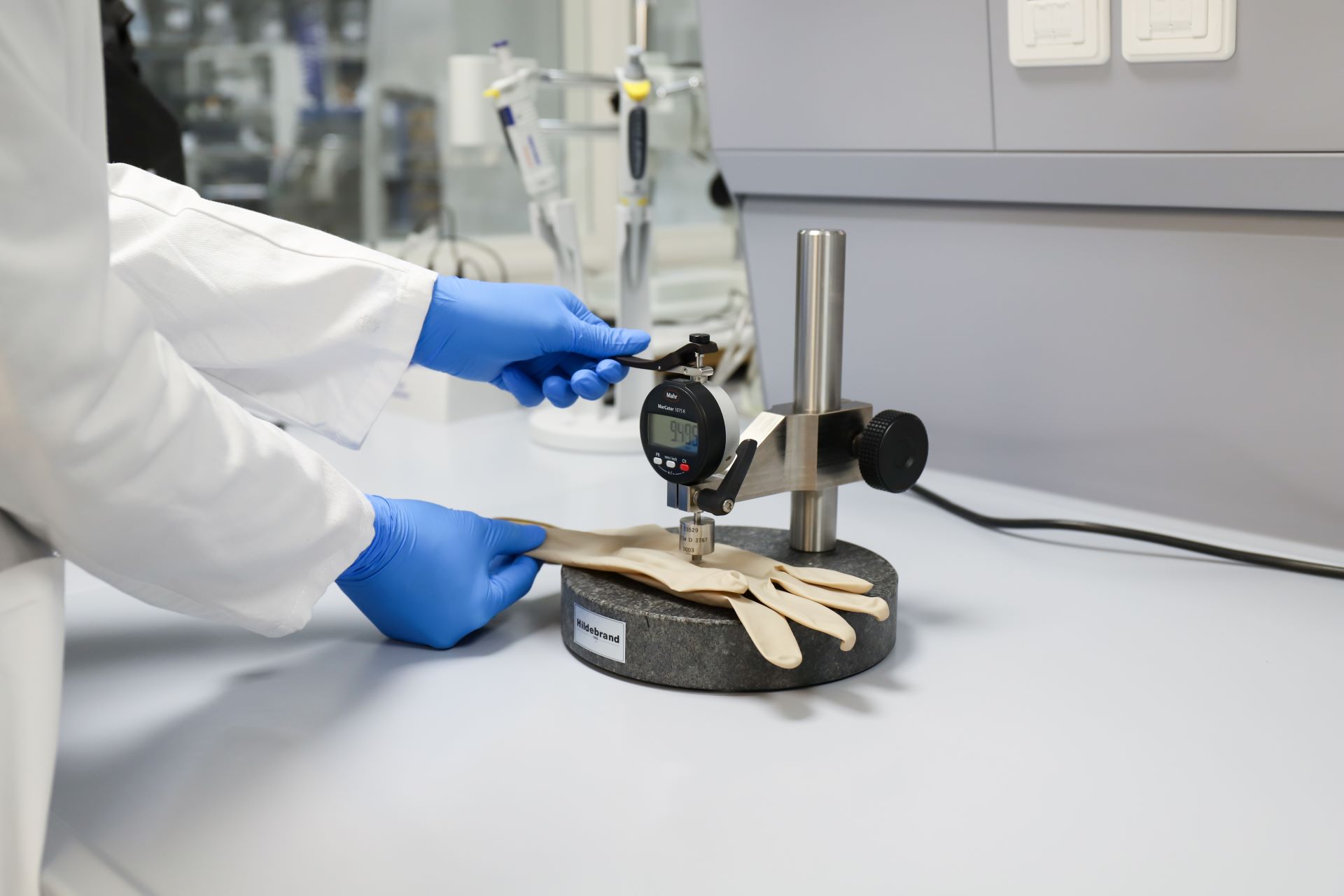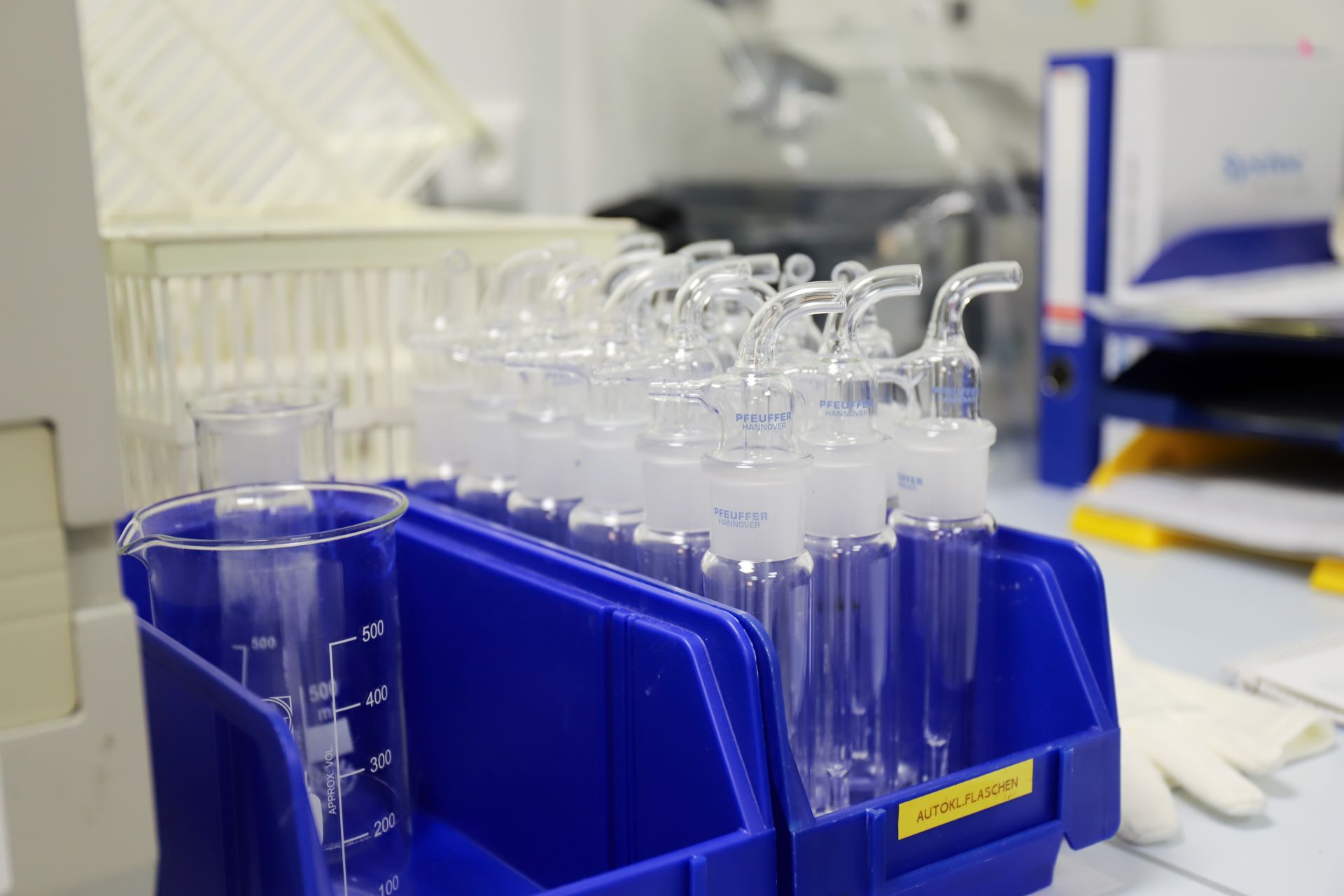In the field of tension - protective clothing in cytostatic drug preparation
Similarly restrictive requirements as for personal protection also apply to product protection in the manufacture of ready-to-use cytostatic preparations. In most cases, these are administered parenterally. Sterility and absence of particles in the manufacturing environment are therefore paramount. With the amendment of the Pharmacy Operations Ordinance [4] in 2012, the specifications for aseptic production were therefore further specified. Since then, the process has been closely oriented to Annex 1 of the EC Guide to Good Manufacturing Practice [5] and provides for narrowly defined purity classes for the manufacturing environment. While the actual preparation manipulations must always take place in an area of purity class A - as a rule, this is the working area of a safety cabinet - the direct environment must normally correspond to class B (exceptions: Class C in the case of proof of drug quality and corresponding validation of the process or Class D when an isolator is used). The personnel who are in this environment must contribute to maintaining the required cleanliness class through their behaviour and equipment. Protective clothing plays a decisive role in this. It ensures that as few germs and particles as possible pass from the wearer's body into the clean environment. Cleanroom clothing is therefore designed to cover the body almost completely. In its function as a filter, it should hold back particles, but allow air to pass through to prevent the particles from "blowing out" at the collar and sleeves. In addition, appropriate pre-treatment must ensure that the protective clothing used is germ-free and does not itself emit any particles.
During the manufacturing simulation, typical transfer steps such as the removal and injection of small volumes of solution were carried out. Two persons were involved in the overall process - an experienced PTA as the "manufacturer" and a "preparer" (Figure 2). The procedure was based on an established method for microbiological manufacturing control in pharmacies [1]. In the course of production, a total of 120 infusion bags were filled with sterile nutrient solution (Figure 3). For this purpose, 960 defined manipulations were carried out in 60 filling runs, which were not allowed to lead to contamination of the nutrient solution at any point in the preparation process. To evaluate the aseptic working method, the filled infusion bags were incubated and visually checked for germ growth. The microbiological contamination of the work area was also checked with the help of sedimentation plates and swab plates.
Whereas until a few years ago the focus of protective activities in the preparation of cytostatics was still on the personnel, efforts are currently concentrating more and more on the most comprehensive hygiene possible to protect the products manufactured. The cleanroom suitability of the protective clothing used therefore plays an essential role in the selection process. Although disposable clothing offers better conditions for implementing personal protection requirements due to its documented integrity, reusable clothing is on the rise in modern preparation laboratories. Special reprocessing procedures and a high degree of breathability ensure that the required cleanroom properties can be implemented more easily. As a result of reprocessing, however, a reduction in impermeability to external contamination is to be expected. However, since neither personal nor product protection can be neglected, the question arises to what extent all legal requirements can be met by the protective clothing available on the market and intended for aseptic CMR preparation work. The answer is still sobering, even if there are signs of improvement compared to a situation analysis carried out a few years ago [6]. There are still hardly any products available which, on the one hand, are certified as Category III chemical protective clothing, but, on the other hand, fully meet the requirements of a GMP Class B clean environment. However, there are signs of an improvement in the market situation. In the meantime, a largely permeation-resistant yet breathable disposable material is being marketed in a version specially pre-treated for use in the cleanroom. Chemical protective clothing made of this material can thus offer both: sufficient protection against toxic liquid splashes and good cleanroom properties through the retention of body particles with simultaneous own particle poverty. So even though there is still no wide range of protective clothing that meets all the prescribed performance requirements, selected products are now available that can replace the previous inadequate or provisional solutions in compliance with regulations. However, even with their use, a systematic risk assessment is indispensable.
[1] Council Directive of 30 November 1989 concerning the minimum safety and health requirements for the use by workers of personal protective equipment at the workplace (third individual Directive within the meaning of Article 16 (1) of Directive 89/391/EEC). (89/656/EEC). Last modified: 27.6.2007. http://eur-lex.europa.eu/LexUriServ/LexUriServ.do?uri=CONSLEG:1989L0656:20070627:DE:PDF.
[2] Council Directive of 21 December 1989 on the approximation of the laws of the Member States relating to personal protective equipment. ( 89/686/EWG ). http://eur-lex.europa.eu/legal-content/DE/TXT/PDF/?uri=CELEX:31989L0686&from=DE.
[3] Ordinance on Safety and Health Protection in the Use of Personal Protective Equipment at Work (PPE Use Ordinance - PSA-BV). Date of issue: 04.12.1996. http://www.gesetze-im-internet.de/bundesrecht/psa-bv/gesamt.pdf.
[4] Ordinance on the Operation of Pharmacies (Apothekenbetriebsordnung - ApBetrO). Date of issue: 09.02.1987. Last amended: 19.12.2014. http://www.gesetze-im-internet.de/bundesrecht/apobetro_1987/gesamt.pdf.
[5] Annex to the announcement of the Federal Ministry of Health on § 2 No. 3 of the Ordinance on the Manufacture of Medicinal Products and Active Substances of 12 March 2008 (BAnz. p.1217). Annex 1 to the EC Guide to Good Manufacturing Practice. Manufacture of sterile medicinal products. http://www.bmg.bund.de/fileadmin/redaktion/pdf_gesetze/bekanntmachungen/Anhang-1-GMP-Leitfaden.pdf.
[6] Klein, M. (2012) Personal protection through cleanroom clothing in cytostatics manufacturing. Pharm. Ind. 11:1774-1780.

 Deutsch
Deutsch
 English
English


